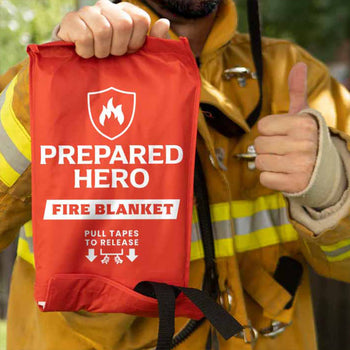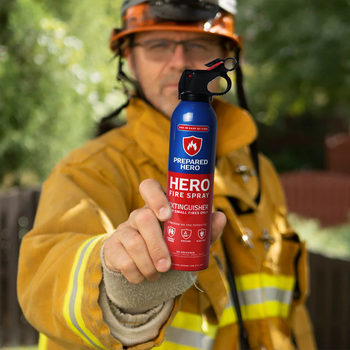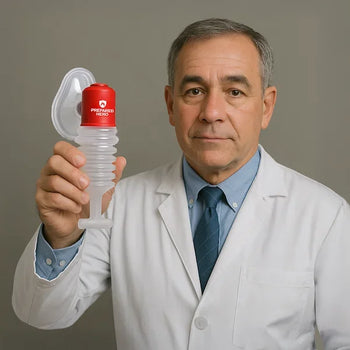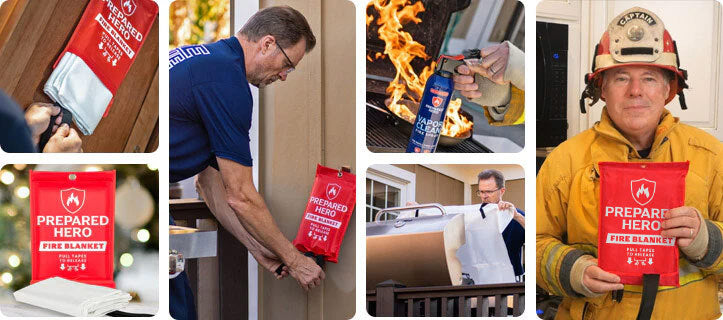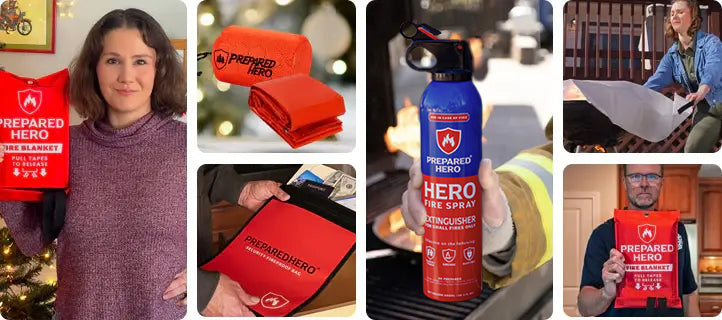Where you put your smoke detectors matters just as much as installing them. Proper placement makes sure they can detect...
Fire safety is more than just having the right tools. It’s also about knowing what burns and how fast it does. If you’ve been dabbling in fire safety, you likely encountered combustibility.
But what exactly is combustibility? Do you need to know about it? Does knowing keep you safe? Find out the answers to these questions and more below.
What Is Combustibility?

Combustibility refers to how easily something can catch fire and keep burning. A combustible material can ignite when exposed to enough heat or a flame. Some materials are more combustible than others, depending on the temperature at which they ignite.
Scientists do fire tests to figure out a material’s combustibility. These tests help set safety rules for buildings, workplaces, and transportation. For example, storing diesel requires more precautions than storing vegetable oil.
Common combustible materials include wood dust, coal, rubber, flour, motor oil, and brake fluid. Knowing what’s combustible helps you stay safe at home and work, especially when you’re using heat.
The Globally Harmonized System of Classification and Labeling of Chemicals (GHS) is an international system that classifies combustible materials into different categories based on their flash point and boiling point. This system helps workers handle materials safely.
Plus, different organizations have their ways of classifying combustibility. The National Fire Protection Association (NFPA) and the Occupational Safety and Health Administration (OSHA) have guidelines for identifying and storing combustible items.
According to NFPA 30, combustibility is different from flammability. Combustibles have flash points of 100°F (37.8°C) to 140°F (60°C), while flammables have flash points less than 100°F (37.8°C).
Is Combustibility a Physical or Chemical Property?
Combustibility is a chemical property. It determines how a substance reacts when it burns. Combustion is a chemical reaction because it changes the material into another form. For instance, burned wood turns into ash and smoke, which are different from the original wood.
On the other hand, physical properties don’t change the substance. Common examples include color, size, and boiling point. You can boil or freeze water, but it’s still the same substance afterward. Combustibility doesn’t work like this, as it only shows up when a chemical reaction occurs.
So if you're trying to figure out what kind of property something is, just ask: Does it change the substance into something new? If the answer is yes, it’s a chemical property. If not, it’s a physical property.
Factors Affecting Combustibility

Ever wonder why some things catch fire easily while others don’t? It all comes down to a few key factors. Here are the factors affecting combustibility:
1. Fuel Type
Different materials burn differently. Paper catches fire easily because of what it’s made of. Metals, on the other hand, usually don’t burn unless under extreme temperatures.
2. Oxygen Availability
According to the fire triangle, fire needs oxygen to stay alive. The more oxygen there is, the faster and hotter something will burn.
3. Temperature
Heat speeds up evaporation and combustion. Higher temperatures mean materials reach their flash points faster.
4. Ignition Source
A flame, spark, or any other heat source is needed to get the fire started in the first place.
5. Surface Area
The more surface area a material has, the faster it can burn. For example, sawdust burns quicker than a solid block of wood because more of it is exposed to heat and air.
6. Humidity
Moisture slows down combustion. Dry conditions or hot weather can make materials less combustible and more flammable.
7. Inhibitors
Substances like water or carbon dioxide can also slow down or stop a fire by cooling it or cutting off the oxygen supply.
8. Physical State
Some materials release more heat when they burn. Others burn faster because of their physical state, like gases or liquids that vaporize quickly.
Why Is Combustibility Important?

Combustibility isn’t just about whether something can burn. From preventing fires to powering homes and cars, it plays a big role in how we live and work every day.
1. Safety
Combustibility helps with fire prevention. Knowing which materials burn easily helps builders and engineers choose safer options for homes, buildings, and public spaces. It also helps people figure out how to store combustible items properly.
If a substance is highly combustible, people need to be extra careful when handling, storing, and transporting it. Combustibility ratings also guide how fire suppression systems are designed and where fire-resistant materials are needed most.
2. Energy Production
Most of our electricity comes from burning fuel in thermal power plants. Combustion drives the turbines that keep the lights on. It also powers most cars, trucks, ships, and planes. Even when a car runs on electricity, that power may have come from a combustion-based power plant. Plus, let’s not forget basic uses like heating homes or cooking food.
3. Industrial Use
Manufacturing facilities need high heat, and combustion is often the cheapest and most effective way to get it. Industries also use combustion to treat waste and create new materials through special high-heat processes. Plus, combustion helps turn trash into energy.
4. Chemical Reactions
Combustion is a fast chemical reaction between fuel and oxygen. It gives off heat and light, which is useful in so many settings. Understanding how this reaction works helps scientists control it better, make it safer, and find new ways to use it.
How to Prevent Fires Due to Combustible Items

A small flame can turn into a major fire in as fast as 30 seconds. Here’s how to keep your home or workplace safe from combustibles:
1. Store the Items Properly
Flammable and combustible materials should be kept in proper storage areas. Use fireproof cabinets for chemicals, fuels, and solvents. You should also store liquids in sealed, approved containers to prevent vapor buildup.
2. Be Careful of Heat and Ignition Sources
Keep combustible materials away from open flames, sparks, and electrical equipment. You shouldn’t smoke near these items. Regularly check your electrical wiring as well, because faulty wires can spark and ignite flammable vapors.
3. Follow Safety Instructions
Always follow safety instructions when using flammable liquids or gases. Use only the amount needed, and seal containers immediately after use. If you need to transfer flammable liquids, do so in well-ventilated areas. Plus, use grounded, non-sparking tools to prevent static electricity from igniting fumes.
4. Use Fire-Resistant Containers
Store flammable liquids in approved, fire-resistant containers for extra safety. Label all containers clearly to avoid mix-ups. Never transfer flammable substances into regular plastic or glass bottles not designed for them.
5. Have Proper Ventilation
Good airflow is essential when handling flammable materials. Fumes from gasoline, paint thinner, and other substances can accumulate and ignite with a small flame or spark. Use exhaust fans in areas where vapors can build up. You should also work in well-ventilated areas to prevent buildup, especially when you’re handling combustible dust.
6. Have Fire Prevention Tools Nearby
Install smoke detectors and sprinkler systems. Keep fire sprays, fire blankets, and fire extinguishers near areas where flammable materials are stored. Plus, make sure your family members or employees know how to use them in case of an emergency.
Fire blankets and fire extinguishers are effective fire safety tools. However, there are differences that you should be aware of.
For one, fire extinguishers are heavier than fire blankets. They also leave a mess, while fire blankets don’t. Plus, fire blankets are easier to use and don’t require training. Fire extinguishers are also harder to store since they are bulky. On the other hand, fire blankets can be hung on walls.
Unlike fire extinguishers, Prepared Hero’s fire blanket doesn’t expire. You can reuse it as many times as you want as long as it’s not damaged. Plus, you can use it to save someone on fire.

Here’s a table summarizing the differences between Prepared Hero’s fire blanket and a regular fire extinguisher:
| Prepared Hero’s Fire Blanket | Regular Fire Extinguisher |
| Lightweight, easy to carry | Heavy, hard to carry |
| Affordable | Expensive |
| Doesn’t expire | Expires |
| Easy to store | Needs more space for storage |
| Non-toxic | Hard to clean |
| Safe for kids and pets | Not safe for kids and pets |
| Doesn’t leave a mess | Leaves a mess |
| Safe for kids and pets | Not safe for kids and pets |
| Can be used on humans and pets | Can’t be used on humans and pets |
Don’t have the budget for a fire extinguisher? No problem!
While fire extinguishers help a lot, they can be expensive, heavy, and hard to store. The residue from the fire extinguisher may also be hard to clean up.
Use a fire spray if you want a more affordable, lightweight, and convenient way to put out a fire in seconds. The Hero Fire Spray will help you deal with minor fire accidents and stop them before they turn into bigger disasters.
Plus, Prepared Hero’s fire spray is biodegradable and non-toxic. Unlike a fire extinguisher, you can safely use it around your family and pets. It’s also eco-friendly, so you’re taking part in saving the environment.

Here’s a table summarizing the differences between Prepared Hero’s fire spray and a regular fire extinguisher:
| Prepared Hero’s Fire Spray | Regular Fire Extinguisher |
| Lightweight, easy to carry | Heavy, hard to carry |
| Easy to store | Needs more space for storage |
| 100% biodegradable | Mostly made of non-biodegradable materials |
| Non-toxic | Toxic |
| Easy to clean | Hard to clean |
| Safe for kids and pets | Not safe for kids and pets |
Do you want reliable, easy-to-use, and affordable tools to put out small fires before they spread? Check out Prepared Hero’s fire prevention tools here, and get up to 51% off on certain items.
7. Train and Educate
Everyone should understand fire hazards and prevention methods. Train employees on proper handling, storage, and disposal of flammable materials. Regular safety drills also reinforce fire prevention and emergency response strategies.
8. Dispose of Waste Properly
Oily rags, chemical-soaked cloths, and empty containers are fire hazards. Dispose of them in metal, self-closing containers designed for hazardous waste. Plus, never throw flammable waste in regular trash bins.
What Are Some Examples of Combustible Materials?

Knowing which materials are combustible helps with fire safety and prevention. Here are some everyday items that can pose a fire risk.
1. Cooking Oil and Grease
Cooking oil and grease don’t ignite as quickly as many believe, but they can catch fire at high temperatures. They can overheat and start a Class K fire when left unattended on a hot stove or oven.
Plus, water doesn’t put out grease fires. Using the wrong extinguisher can make things worse. Find out what extinguisher to use for kitchen fires here. You can also use fire blankets on grease fires.
2. Plastic
Contrary to popular belief, plastic is classified as an ordinary combustible. Many household items, like plastic decor, storage, and tools, can melt and release toxic gases before catching fire.
3. Fabric
Some natural and synthetic fabrics are combustible, especially if they’re untreated. For instance, cotton and polyester can catch fire if exposed to heat or open flames. Some synthetics also melt before igniting. Loose, flowing fabrics, such as curtains and bedding, burn even faster.
4. Wood
Dry wood, lumber, and plywood are highly combustible. Sawdust is even more dangerous because it has a larger surface area and can ignite easily. Wood can catch fire from sparks, faulty wiring, or prolonged heat exposure in homes, factories, and construction sites.
5. Diesel
Diesel doesn’t ignite as easily as gasoline, but it will burn when heated enough. It produces vapors that can catch fire under the right conditions. Since diesel is widely used in trucks, generators, and industrial machinery, safe storage and handling are crucial.
6. Hydraulic Fluid
Hydraulic fluid, like mineral oil-based ones, can catch fire when exposed to high heat or sparks. Even synthetic and biodegradable fluids can burn if hot enough.
How to Store Combustible Items

Storing combustible items properly prevents fires and accidents. Whether at home, in a workshop, or at a business, following safe storage practices protects everyone. Here’s how to store combustible items the right way:
1. Choose the Right Storage Area
Keep combustible materials in a cool, dry place. Avoid storing them in basements or enclosed spaces where heat and vapors can accumulate. A well-ventilated storage area prevents dangerous fumes from building up.
2. Use Proper Containers
Store combustibles in sealed, non-reactive containers. Don’t use flimsy plastic or paper packaging that can catch fire. You should also use leak-proof metal or approved containers with tight-fitting lids when storing combustible liquids.
3. Store Them Away from Ignition Sources
Sparks, flames, and electrical equipment can quickly ignite combustible items. Put them away from lighters, matches, candles, power tools, electrical outlets, and other heat sources.
4. Label Everything Clearly
Mislabeling or not labeling containers can lead to accidents. Clearly mark all combustible items with hazard labels and safety instructions. You should also list down the materials so you know what’s on hand and where it’s located.
5. Don’t Overcrowd Them
Don’t stack combustible items too close to each other. Keep them organized and easy to access so they don’t get damaged or knocked over. Leaving space between the items also improves airflow and reduces heat buildup.
6. Separate from Flammables
Combustible materials should not be stored near flammable liquids, corrosive chemicals, or oxidizers. Certain chemicals can react and cause fires or explosions when mixed. Always check safety guidelines to make sure you’re storing materials properly.
7. Use Fireproof Cabinets
Workplaces or storage areas with many combustibles should be stored in fire-resistant cabinets or storage rooms. They help contain fires if something ignites and protect combustibles from external fire hazards.
What Is an Example of Combustibility?

An example of combustibility is wood dust. It won’t burst into flames on its own, but if it’s exposed to enough heat, it’ll catch fire and keep burning. Other common combustible materials include rubber, diesel, oil, and charcoal. They don’t ignite as easily as flammable items, but they can burn if there’s enough heat.
You’ll find combustible items in most homes and workplaces. For this reason, you should keep them away from stoves, ovens, space heaters, and other heat sources. Combustibles might not seem dangerous, but they can fuel a fire once they ignite.
Knowing what’s combustible and flammable helps you stay safe at home and work. Store these items properly and don’t pile them near heat sources, and you’re good to go.
Can Something Be Combustible but Not Flammable?
Yes, something can be combustible but not flammable. The difference lies in how easily they ignite. Flammable materials ignite quickly, even at low temperatures. On the other hand, combustible materials need more heat to catch fire.
According to NFPA 30, combustibles have flash points of 100°F (37.8°C) to 140°F (60°C), while flammables have flash points less than 100°F (37.8°C).
Combustible materials have higher flash points, so they’re less likely to ignite under normal conditions. However, that doesn’t mean they’re safe around open flames. With enough heat, combustible materials can still burn. So while they’re not as risky as flammable substances, you still have to be careful with them.
How Do You Tell if Something Is Combustible?

You can tell if something’s combustible by checking its flash point. If it has a flashpoint of 100°F (37.8°C) or more, it’s combustible. If it’s less than that, it’s flammable.
This means it won’t ignite as easily as something flammable, but it can still burn if it gets hot enough. Substances like cooking oil, wood dust, diesel, and charcoal fall into this category. You can usually find the flash point on the product’s label or safety data sheet. Knowing this helps you handle and store the materials safely.
How Is Combustibility Measured?
Combustibility is measured by testing how easily a material catches fire, how fast it burns, and how much smoke or toxic gas it gives off. Common tests include vertical and horizontal flame tests, burn rate, and auto-ignition temperature.
These tests show how a material reacts to heat or flames, whether it self-extinguishes, and how quickly fire spreads. The results help manufacturers meet safety standards, compare products, and figure out how risky a material is.
What Are the Different Types of Combustibility Tests?

Combustibility is measured through tests that check how easily something catches fire, how fast it burns, and how it behaves during a fire. These tests help figure out how risky a material is in different settings. Here are the most common combustibility tests:
1. Flammability Tests
These tests check how easily something ignites and how flames spread. For example, the Vertical Flame Test determines if a material can self-extinguish. On the other hand, the Horizontal Flame Test is used for plastics and other materials to determine how fast flames spread. Meanwhile, the Limiting Oxygen Index shows the oxygen level needed to keep a fire going. Lastly, the Cone Calorimetry and Burning Rate Test measure how fast heat and flames spread.
2. Fire Resistance Tests
Fire resistance tests see how long a material can withstand fire. They track how well something holds up under heat. For instance, the Single Burning Item Test looks at how one item reacts to a flame.
3. Ignition Tests
Other ignition tests measure smoke, heat output, or how toxic the smoke is. For instance, the Auto-Ignition Temperature Test and Minimum Ignition Energy Test determine ignition points.
How Does Temperature Affect Combustibility?
Temperature affects combustibility by determining how easily something catches fire. When the temperature goes up, materials release more vapors into the air. These vapors mix with oxygen, making it easier for a fire to start.
Higher heat can also lower the flash point, which is the temperature at which a liquid gives off enough vapor to ignite. It also affects the lower flammability limit, so less vapor is needed for combustion.
As temperatures rise, the range gets wider, and the material can catch fire more easily. In short, the hotter it gets, the more likely it is that something combustible will burn.
What Is the Difference Between Combustibility and Diffusion?
Combustibility and diffusion are two different things. Combustibility is all about whether a material can catch fire and burn. If something is combustible, it means it has the ability to ignite when exposed to enough heat and oxygen.
On the other hand, diffusion refers to the movement of particles like gases or vapors from an area where there's a lot of them to an area where there's less. In fires, diffusion comes into play with how fuel and oxygen mix. In a diffusion flame, the fuel and oxygen don’t mix ahead of time. They meet and burn only at the surface of the flame.
So while combustibility tells you if something can burn, diffusion affects how the burning happens, especially in flames that aren’t premixed.
What Are the Levels of Combustibility?
Combustibility levels indicate the extent to which a material can contribute to a fire. The scale goes from A1 to F. A1 and A2 are non-combustible, which means they won’t catch fire easily, if at all. B to D are still combustible but have low to medium fire risk. E and F are the most flammable because they catch fire quickly and burn fast. These ratings help builders, manufacturers, and safety experts know which materials to use, especially in fire-prone areas.
Conclusion
Combustibility affects how we build things, how we stay safe, and how we manage fire risk. Knowing which materials can burn and how they react to heat helps prevent accidents and keeps systems running smoothly. Whether it's for safety, energy, or industry, understanding combustibility helps us make smarter choices. Stay safe, hero!


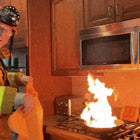 Fire
Fire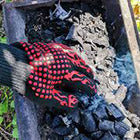 Safety
Safety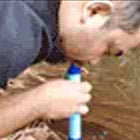 Survival
Survival Protection
Protection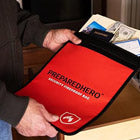 New
New
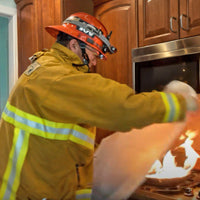 Fire
Fire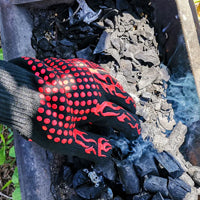 Safety
Safety Survival
Survival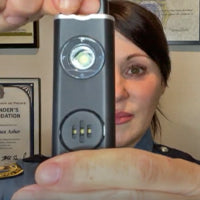 Protection
Protection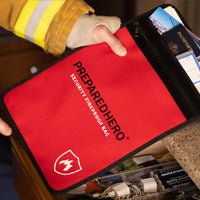 New
New
